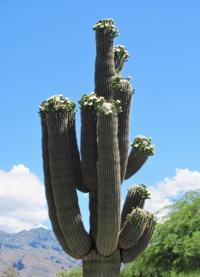These photos of cactus blooms will make you fall in love with Tucson
- Updated
Prickly pears, chollas and saguaros have been bringing brilliant hues of yellow, red and white to deserts around Tucson. The cactus color show typically is more dependable than that of annual wildflowers, which require well-spaced autumn and winter rains to produce a good bloom.
Cacti “store water and they’re adapted to go dormant in droughts. They can preserve enough water to bloom,” said Mark Fleming, curator of botany at the Arizona-Sonora Desert Museum west of Tucson.
“In a good year, they might have multiple bloom cycles,” Fleming said. “But they almost always have enough water to do one cycle.”
About the blooms:
- Prickly pears, a type of cactus easily identifiable by their paddle-shaped pads, produce mostly yellow flowers in the Tucson area. They are typically bright yellow on the first day of their bloom, fading to a sort of peach color on the second day. A few prickly pears produce blooms of other colors.
- Cholla cacti of several species grow in the Tucson area and produce blooms ranging from yellow and orange to red, purple and pink.
- Saguaros have dramatic creamy-white flowers. The blossoms of saguaros open at night and close the following midday or afternoon. Although individual flowers last only a day, a single saguaro can produce blooms for weeks.
- Hedgehog cacti typically bloom earlier in April with vibrant magenta flowers.
- Pincushions are very small cacti that produce showy pink flowers within about five days of a soaking summer rain.
- Barrel cacti are among the late bloomers of the cactus world. They usually show their yellow to red flowers in July and August
Where to see them:
You’re apt to see them almost anywhere throughout the Tucson area, including urban and foothills neighborhoods.
Cactus blooms
Updated
Cactus blooms
Updated
These cactus blooms were taken by reader Jim at his home in the Dove Mountain area.
JimCactus blooms
Updated
Cactus blooms
Updated
These cactus blooms were taken by reader Jim at his home in the Dove Mountain area.
JimCactus blooms
Updated
Cactus blooms
Updated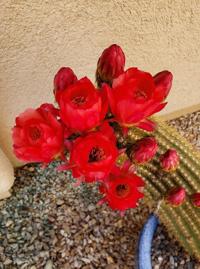
Cactus blooms
Updated
These cactus blooms were taken by reader Jim at his home in the Dove Mountain area.
JimCactus blooms
Updated
Cactus blooms
Updated
Cactus blooms
Updated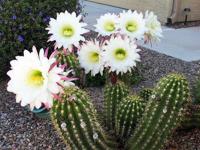
Cactus blooms
Updated
Cactus blooms
Updated
Cactus blooms
Updated
Cactus blooms
Updated
Cactus blooms
Updated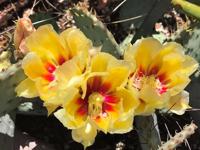
Cactus blooms
Updated
Blooming saguaro
Updated
A saguaro blooms in the Catalina Foothills. Blooms can be unpredictable, but peak blooms usually occur from mid-May to mid-June.
photos by Doug Kreutz / Arizona Daily StarCactus blooms at the Arizona-Sonora Desert Museum
Updated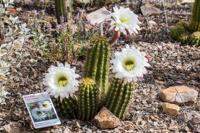
Prickly pear in bloom
Updated
Another prickly pear’s bloom has a splash of red.
Doug Kreutz/Arizona Daily StarCactus blooms
Updated
Prickly pear
Updated
A small prickly pear cactus in colorful bloom.
Doug Kreutz/Arizona Daily StarBrilliant bloom
Updated
Saguaros are blooming brilliantly in parts of the Tucson Valley. -- Credit: Doug Kreutz/Arizona Daily Stars
Doug Kreutz/Arizona Daily StarsPrickly pear cactus
Updated
A prickly pear cactus in brilliant bloom.
Doug Kreutz / Arizona Daily StarPrickly pear cactus
Updated
Yellow prickly pear blooms and hikers in Tucson Mountain Park.
Doug Kreutz / Arizona Daily StarSaguaro and ocotillo
Updated
A blooming saguaro with an ocotillo in bloom nearby.
Doug Kreutz / Arizona Daily StarHedgehog cactus
Updated
A hedgehog cactus shows off its bright blooms.
Doug Kreutz / Arizona Daily StarCholla cactus
Updated
A cholla cactus with yellow blooms.
Doug Kreutz / Arizona Daily StarCholla cactus
Updated
A cholla cactus with red blooms.
Doug Kreutz / Arizona Daily StarPrickly pear
Updated
A prickly pear cactus with red blooms in the desert west of Tucson.
Doug Kreutz / Arizona Daily StarBees and blooms
Updated
Bees visit the blooms of a saguaro cactus.
Doug Kreutz / Arizona Daily StarYellow prickly pear flowers
Updated
Yellow flowers of prickly pears add color and beauty to Tucson Mountain Park west of the city.
Doug Kreutz / Arizona Daily Star07 VAM outside birding trail
Updated
Red cactus blooms decorate the Birding Trail.
Prickly pear cactus
Updated
Blooms and buds of flowers to come on a prickly pear cactus.
Doug Kreutz / Arizona Daily StarCactus blooming
Updated
Saguaros will be blooming this month at Saguaro National Park . -- Credit: Doug Kreutz / Arizona Daily Star
Doug Kreutz / Arizona Daily StarBonanza of blooms
Updated
This cactus in the Catalina Foothills is in a blooming mood — and it’s just getting started. Still more buds than blooms.
Doug Kreutz / Arizona Daily StarSabino Canyon saguaro
Updated
A blooming saguaro in Sabino Canyon with more buds waiting to open.
Doug Kreutz / Arizona Daily StarMultiple blooms
Updated
A saguaro with multiple blooms in Sabino Canyon.
Doug Kreutz / Arizona Daily StarCactus Flower
Updated
Tucson Arizona
By frank worthTrichocereus cactus in bloom
Updated
Trichocereus cactus in bloom
By jamie rCardon in bloom
Updated
Cardon in bloom on 3rd Street bike path
By Mary BlackBarrel Cactus in Bloom
Updated
Late bloom on a barrel cactus
By Keith JohnstonFoothills flowering cactus
Updated
Cactus wreathed in pink blooms
By Kerry GilbraithAs featured on
You might have been driving around Tucson these last few weeks and noticed our beloved sagua…
Ocotillo plants and some cacti add red blooms to the desert landscape.
It's turning out to be a banner year for saguaro blooms.
More information
- 18 photos of palo verde trees guaranteed to make you sneeze
- 10 fun facts about palo verde trees
- Palo verde trees push wildflowers out of the desert-bloom spotlight
- A few saguaros around Tucson have begun to bloom in early April
- Wildflowers may be fading, but cactus blooms fill the void in Tucson area
- Tucson gets triple-digit temperatures for the first time in 2019
- Widespread legalized gambling comes soon to Arizona; here's what to know
- Tucson could get new casino under Arizona's latest gaming pact
- Ducey declares 'vaccine passport' ban for Arizona
- After yearlong closure, Tucson restaurant to reopen with rooftop dining
- Tucson City Council approves $30 million in raises for employees
- A large distribution center is coming to Marana
- Proposed pet breeding facility in Cochise County draws opposition from Tucson, beyond
- Gov. Ducey eliminating $300 weekly federal jobless benefits to help struggling businesses
- Arizona budget plan would massively cut tax collections, create flat income tax rate
- Tucson considers making room for more casitas
- Trust buys historic farm south of Tucson once proposed for residential development
- Want to escape? Try these daycation options at Tucson-area resorts
- Arizona Senate overrides a governor's veto for first time in 40 years
View this profile on Instagram#ThisIsTucson 🌵 (@this_is_tucson) • Instagram photos and videos
Most viewed stories
-
A list of places that will be open on Christmas Day 2025
-
Over 40 free events happening in Tucson this December! ⛄
-
A local gift guide for the foodie in your life 🍽️
-
40 exciting things to do in Tucson December 19-21! ⭐
-
More than 40 fun events in Tucson, December 12-14! ❄️✨
-
3 teaspoons of anise, 6 cups of flour and lots of love: My grandma's biscochitos recipe is more than a delicious cookie
-
Save the date! Here's the ultimate list of Tucson holiday events 🎄
-
17 festive holiday markets that support Tucson artisans
-
Ring in 2026 at these fun local New Year's Eve events 🥳
-
‘Less screen time, more hobbies:’ Tucson journaling group helps young adults connect




